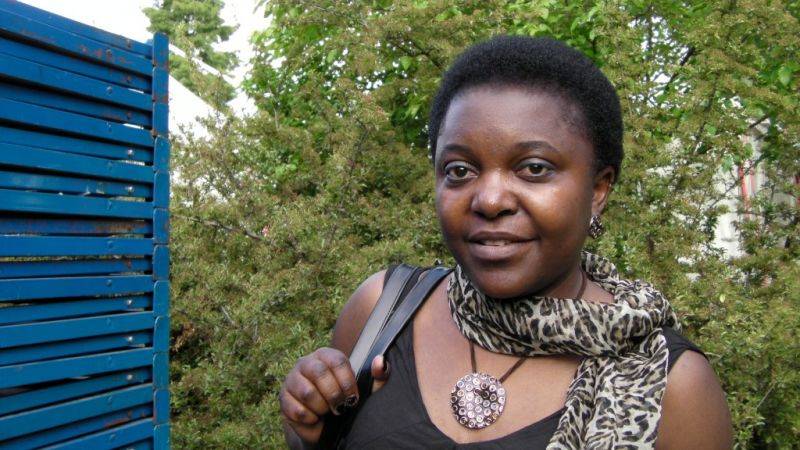Cécile Kyenge in the Hot Seat
ROME - For the past two months of the new government Dr. Cécile Kyenge has held down one of the toughest jobs in Italy. As Minister for Integration it has fallen her lot to deal with such contentious issues as citizenship for children born in Italy of immigrant parents. She is herself an immigrant. Born in Congo, Kyenge came to Italy 30 years ago to study medicine and work as an opthamologist before entering politics in North Italy. For her pains, in recent weeks she has been the object of literally obscene invective and even death threats. "I am not afraid," she told foreign journalists in Rome this week.
Her task is daunting. The southern isle of Lampedusa is a chief port of entry for migrants from sub-Sahara and North Africa, especially via Libya. After being processed on the Italian island most are sent onward with a six-months permit allowing them to seek work. Even so, that this influx puts Lampedusa to the test is understatement. Between February and April more than 30,000 migrants arrived by sea, and this month's milder weather is bringing new hordes. On June 12 alone the United Nations refugee agency (UNHCR) registered 1,500 migrants who arrived from North Africa on seven rickety boats. Among the new arrivals: a baby born aboard one of these boats. Rough seas meant that some who could not swim drowned. Most lack identification, so all but one are buried in anonymous graves in the island's crowded hillside cemetery. (See >>>)
The holding center where these migrants are processed is chronically overcrowded, and on June 20, in his sermon in the Basilica of Santa Maria in Trastevere, Cardinal Antonio Maria Veglio, who presides over the Pontifical Council for Migrants, appealed to the European Union to participate at Lampedusa. "It is not right that Italy be left alone by Europe on the issue of immigration. Lampedusa is now Europe's port for immigrants and refugees, and the EU should set up a center for them," said the Cardinal.
No one is forgetting that Italy itself was a country whose citizens migrated from their homes throughout Italy, as is excellently documented in the National Museum of Emigration in the Vittoriano at Piazza Venezia (see: >>>). Between 1876 and 1976 some 24 million Italians emigrated, with no less than 870,000 setting sail in a single year, 1913. Despite the strain on the island, Lampedusans themselves care enough for the desperado arrivals - and most are desperate - that a group has created a small museum of found objects and letters that have been washed up on the shore. Among the items on view there are Korans, photos, shoes and life jackets. (See >>>)
Following the Italian economic boom years of the Seventies, with 7% annual growth, migrants began reaching Italy in greater numbers than the departures. Many of these were Italians returning home. But in 1981 the national statistics agency ISTAT reported 321,000 foreign presences; ten years later the figure had doubled, to 625,000. Last year, as official statistics show, one out of every 12 in Italy was a foreigner, for 8.2% of the total Italian population. The largest immigrant community is Romanian (1,073,000) followed by Moroccans (507,000) and Albanians (492,000). Most are Christian (2.5 million) while 1.5 million are Muslim.
With them come the new problems which Italy must face. "I am working toward full integration of migrants," Kyenge said, "in a fusion of values in which all can recognize each other, in a community that brings riches to each other." Asked if after her 30 years here she sees Italy as racist, Kyenge chose her words carefully: "Italy needs to know the value of immigration and to learn that the 'other' represents cultural wealth. Immigrants are a resource."
Not everyone agrees. After an immigrant from Somalia tried to rape two Italian girls, Dolores Valandro, activist in the Northern League in Padua, Tweeted that, since Kyenge obviously did not understand what that meant to the victims, "Why doesn't somebody rape Kyenge?" The outcry came from right, left and center, and Valandro was promptly expelled from the party. "I don't respond to violence with violence," Kyenge said. "Everyone should feel offended by this." Enrico Letta, Premier, agreed. "I for one consider myself offended." On the other hand, a grand guru of Italian commentators, Giovanni Sartori, writing in the daily Corriere della Sera, opened a flood gate of protests when he asked of Kyenge, "What does she know about integration?" He criticized Letta for having installed as minister in a particularly sensitive post an individual like Kyenge with limited experience. One might agree with this, but he then assailed the minister for having called Italy a country of "metiches", using a word commonly associated with non-pedigree dogs. "Brazilians may be 'metiches,'" declared Sartori, setting off firestorms on a hundred fronts. "Not Italians."
He should have known better.


































i-Italy
Facebook
Google+
This work may not be reproduced, in whole or in part, without prior written permission.
Questo lavoro non può essere riprodotto, in tutto o in parte, senza permesso scritto.